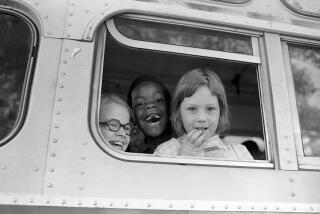Rethinking the Move Away From Single-Sex Schools : Education: Research suggests that girls do better when they don’t have to share the classroom with boys.
The big newspaper ad for one of America’s oldest, most prestigious girls schools made its point most succinctly in the photo caption:
“At single-sex schools, girls are the heroes, the problem-solvers, the innovators. All classroom voices are theirs, as are all honors, gavels, and leading roles.”
The ad, featuring a picture of a confidently smiling young woman, was part of a series run in the fall by the Emma Willard School in Troy, N.Y. The series caused something of a stir in the usually placid world of private institutions because it tweaked some of the school’s competitors--the big-name, former boys schools that have gone coeducational.
But a growing body of research, including recent national surveys of public school students and private girls school graduates, seems to bolster the ad campaign claims that adolescent girls do better when they don’t have to share the classroom with boys.
The findings have given some hope to advocates of single-sex education who have watched in consternation as the numbers of all-boys and all-girls schools plummeted during the 1960s and 1970s. A number merged with opposite-sex schools while others went coeducational in the face of declining interest in single-sex schools.
The National Assn. of Independent Schools, which represents non-parochial college-preparatory schools, reported that during the 1963-64 school year, only 38% of its approximately 900 institutions were coeducational. By the 1990-91 school year, that proportion had risen to 79%.
Roman Catholic schools, the largest segment of the non-public school spectrum, experienced a similar phenomenon. Today, there are only about 300 girls schools and 200 boys schools; together they represent about 38% of the 1,300 Catholic secondary schools in the United States. Within the Archdiocese of Los Angeles, however, the 43 single-sex schools represent nearly 80% of the 54 secondary schools. And nearly all of New York’s inner-city Catholic high schools are either all-girls or all-boys because officials there believe single-sex schools work best.
The controversial merger last year of Westlake School for Girls in Holmby Hills with Harvard, a prestigious boys school in North Hollywood, left only two secular girls schools in Los Angeles County--Westridge in Pasadena and Marlborough in Hancock Park, both affiliated with the National Assn. of Independent Schools.
“It seems unfortunate in a sense that, just as research is showing there may be some benefits (to single-sex education), especially for girls, the trend is only one direction--down and out,” said University of Michigan education professor Valerie E. Lee, who has participated in some of the recent research on single-sex schools.
“I can’t think of a single single-sex school that was opened in recent years. There is a strong group of supporters of single-sex education, but it is small, and it has not grown,” Lee said. She noted that the public-school-educated parents who are choosing private schools for their children are more likely to opt for coeducational institutions because they are “more like what the parents are used to.”
Studies comparing Catholic school students at coeducational campuses with those in single-sex schools found students at all-boys or all-girls schools tend to have higher educational aspirations, do more homework and have more positive views of their own school. For the most part, the differences were strongest for girls. Other research suggests that boys tend to dominate discussions in coeducational classrooms and are more often elected to school leadership posts, thus helping perpetuate sex stereotyping.
A survey released last year by the American Assn. of University Women found that large numbers of once-confident little girls emerged from adolescence with poor self-images and lower expectations. The survey of 2,400 girls and 600 boys in public schools throughout the country confirmed some earlier, smaller studies.
By contrast, a survey of about 1,200 women, commissioned by a coalition of girls schools and conducted by Yankelovich Clancy Shulman, a Washington-based public opinion firm, found most alumnae of single-sex schools to be successful, independent, confident and involved in their communities. Graduates of girls schools said their educations gave them greater self-confidence and more ambition.
Further, in a strong indictment of the ways girls are treated in the nation’s public schools, the American Assn. of University Women in February released a report that brought together two decades of research. Based on hundreds of studies, the report concluded that girls receive less classroom attention than boys, are discouraged from taking challenging math and science courses and are subjected to curricula that reinforce gender stereotypes.
The research has drawn controversy. Some educators believe the differences can be explained by other attributes in the schools studied--individual attention, a caring atmosphere, positive role models, high academic expectations--that are not limited to single-sex campuses. And some researchers, aware that schools sometimes seize on their findings to market their schools, are concerned that too much may be read into the studies.
The debate over single-sex schools has been heightened by controversial proposals to form all-male academies for African-Americans in Milwaukee and some other cities. Advocates of these schools argue that they would provide positive role models and promote strong self-esteem, some of the very benefits claimed by proponents of girls schools. But critics question the wisdom of sequestering students from other groups within the larger society they must live in.
Yet those most intimately involved with girls schools say the benefits are real.
Barbara E. Wagner, head of Marlborough School, which has been educating young women for more than 100 years, said that when she first arrived three years ago she immediately was struck by the Marlborough girls’ “ability to be articulate, to ask probing questions. It just jumped out at me.”
Wagner, who had always worked in coeducational schools, said she has seen none of the “hanging back” found so often in girls entering adolescence, nor any concerns about their appearance and how boys would react to them.
“I believe (single-sex education) has afforded young women the opportunities, really encouraged them, to become leaders, outstanding academicians, including in math and science, and good athletes,” Wagner said. “The girls here feel very competent. They dream big dreams, and they see anything is possible for them.”
Her impressions were echoed in a recent student survey in which large numbers of girls--especially those in grades seven through 10--said they were pleased to be able to “be themselves” and not be overly concerned with appearance. They also said they felt “less distracted” from their studies and liked “not having to compete with boys” or to feel intimidated. But some were concerned about whether they would be ready for such competition when they got to college.
Student Body President Julie Saliba, a senior in her sixth year at Marlborough, said there was a time in ninth or 10th grade when she questioned the wisdom of going to a girls school. But then she began noticing differences “in maturity level, confidence, things like that,” between her classmates and her friends in coeducational schools.
“Now I’m really glad. I know I wouldn’t have talked up as much in class if I hadn’t. . . . I wouldn’t have run for student body president or have done the things I’ve done at Marlborough. This was right for me.”
Ed Jensen, an Arcadia father of three daughters educated at Alverno High School, a Catholic girls school in Sierra Madre, has become an ardent fan of single-sex education.
“This school gives our girls permission to be terrific, to speak out, express themselves. . . . There is a real positive feminism there,” Jensen said.
If he and his wife, Mary Lynne, a teacher, had any doubts about how well the girls would fare after high school, they vanished after their eldest, Jennifer, 19, graduated and entered Cal State Long Beach last year.
“It was a culture shock, but she was really well prepared for it. She’s done very well academically and socially,” Jensen said.
With feelings as strong as these, it is not surprising that the demise of a single-sex school is often accompanied by a lot of anguish. Some parents of students at the highly regarded Westlake School tried--unsuccessfully--to block its recent merger with Harvard. There was quieter but heartfelt grieving among alumni when Pater Noster, a Catholic boys high school in Glendale, closed last year.
Occasionally there has been some retrenching. Two schools in the East--Miss Hall’s, a Pittsfield, Mass., boarding school for girls, and Trinity-Pawling, a boys boarding school in Pawling, N.Y.--jumped on the coeducational bandwagon in 1974. Both went back to their single-sex status a few years later.
And there is at least some rethinking at the prestigious Webb Schools in Claremont. Officials believe they had the perfect solution with their unusual brand of “coordinate” education for their combination boarding and day schools, Webb School of California (for boys, founded in 1922) and Vivian Webb School (for girls, founded in 1981).
The two schools have their own student governments and activities, but boys and girls have taken meals and attended classes together on the same wooded hillside campus since the girls school was added 11 years ago.
“There are values and benefits (in coeducational and single-sex schools) for both boys and girls, and we believe we have found a way to have the best of both worlds,” said Susan A. Nelson, head of both schools. “We are always looking at ways to enhance the program, and the coordinate structure allows” great flexibility.
This year, based on the research that indicates there are benefits to single-sex classrooms, Nelson said Webb officials are considering a few more changes. In a partial return to the old days, they might be adding a few sections of academic subjects, some just for boys and others just for girls.
California Private School Enrollment
In thousands, for the school year beginning in September ‘85: 536,920 ‘90: 531,489 * Includes only private schools with six or more students.
SOURCE: California Dept. of Education, Sacramento







